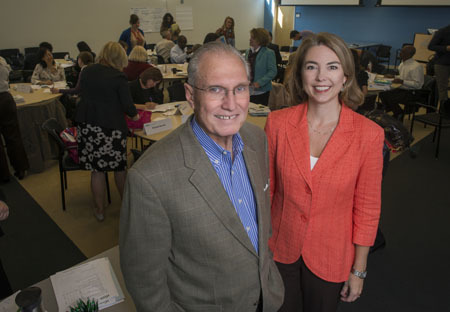by Whitney Hopler, Communications Manager
Leaders face many stressful situations and challenging problems in the workplace, but in the middle of all that, one simple decision can empower them to be successful: positivity. When leaders choose to be positive and act on that choice regularly, they can do their best work, lead others to fulfill their potential, and achieve their organization’s goals – all while enjoying the process. Dr. Steve Gladis and Dr. Beth Cabrera, a senior fellow and scholar at our center, work together on a popular Positive Leadership Certificate program that teaches people the skills they need to put positivity into practice on the job every day.
Focusing on the positive opens leaders’ minds to new ideas (such as solutions to problems) that they wouldn’t necessarily be able to discover otherwise, Gladis and Cabrera said.
“Using the skills we teach (mindfulness, positive leadership, purposeful work, and coaching) creates a mindset of positive ‘can do’ and not a must-do one,” said Gladis. “Being a leader is a tough job and staying on the positive side of that experience requires focus and discipline. The long-term results are well worth it both for the leader and the organization. Truly, a leader’s emotions (positive and negative) are caught – through emotional contagion. And the statistics and outcomes of leaders who get people positive and engaged prove that positivity is worth the investment in time, energy and budget.”
Cabrera pointed out that, “Research shows that positive emotions and having a sense of purpose boost optimism, confidence, creative thinking, and resilience. So teaching leaders how to create a more positive workplace not only improves the well-being of their employees, but also has a positive impact on the bottom line.”
While it’s often negative stories about leadership that make the news, positive leadership is what really motivates people to achieve success, they said.
“If you present things in a more positive way, it actually leads to action, not helplessness, as negative news stories do,” Cabrera said. “It motivates people to take positive action. It also broadens their minds so they’re more receptive and creative.”
Our culture is filled with negative messages, and people who practice positive leadership can become powerful change agents, said Gladis. “In today’s world of turbulence and angst, there’s a real need for positive leadership.”
Both Gladis and Cabrera said that the skills they teach in the program have powerfully strengthened their own well-being. For instance, Gladis has made a habit for years of writing down three things that went well in his day every evening before going to bed, and said that exercise consistently shifts his mindset toward positivity. Cabrera has used mindfulness skills to overcome a tendency to worry and found that especially helpful.
It makes sense for people to invest in their futures by participating in the program, they said.
“I have maintained contact with some of our students and they continue to rave about the program,” said Gladis, noting that former students tell him that they continue to use the material they have learned not only for themselves, but also with their families and companies.
Cabrera said that the program can benefit people both personally and professionally. “Learning to be a more positive leader impacts people on a personal level, helping them to experience greater success and well-being, while also teaching them specific strategies for boosting the performance of their team,” she said. “It’s a no-brainer!”

